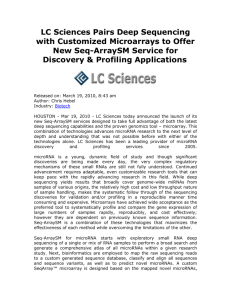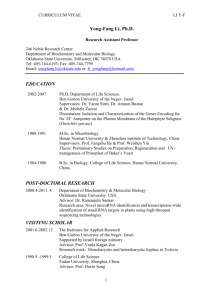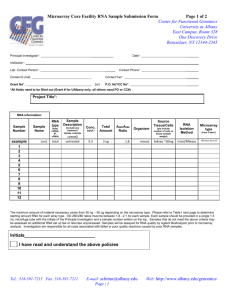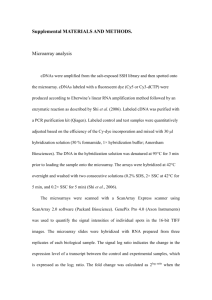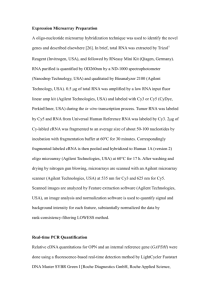Kurokawa et al. 1 Supplementary Information Data S1
advertisement
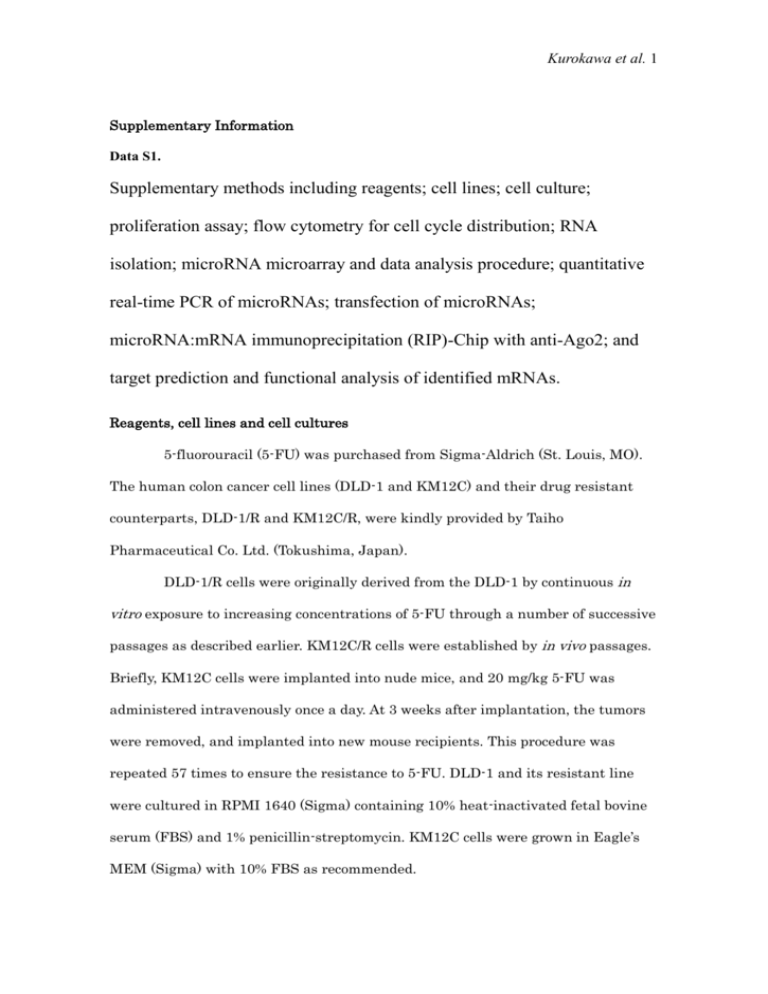
Kurokawa et al. 1 Supplementary Information Data S1. Supplementary methods including reagents; cell lines; cell culture; proliferation assay; flow cytometry for cell cycle distribution; RNA isolation; microRNA microarray and data analysis procedure; quantitative real-time PCR of microRNAs; transfection of microRNAs; microRNA:mRNA immunoprecipitation (RIP)-Chip with anti-Ago2; and target prediction and functional analysis of identified mRNAs. Reagents, cell lines and cell cultures 5-fluorouracil (5-FU) was purchased from Sigma-Aldrich (St. Louis, MO). The human colon cancer cell lines (DLD-1 and KM12C) and their drug resistant counterparts, DLD-1/R and KM12C/R, were kindly provided by Taiho Pharmaceutical Co. Ltd. (Tokushima, Japan). DLD-1/R cells were originally derived from the DLD-1 by continuous in vitro exposure to increasing concentrations of 5-FU through a number of successive passages as described earlier. KM12C/R cells were established by in vivo passages. Briefly, KM12C cells were implanted into nude mice, and 20 mg/kg 5-FU was administered intravenously once a day. At 3 weeks after implantation, the tumors were removed, and implanted into new mouse recipients. This procedure was repeated 57 times to ensure the resistance to 5-FU. DLD-1 and its resistant line were cultured in RPMI 1640 (Sigma) containing 10% heat-inactivated fetal bovine serum (FBS) and 1% penicillin-streptomycin. KM12C cells were grown in Eagle’s MEM (Sigma) with 10% FBS as recommended. Kurokawa et al. 2 Cell proliferation assay The proliferative behaviors of drug-sensitive (parental) and resistant cells were determined. Cell growth was assayed using the CellTiter 96 AQueous One Solution Cell Proliferation Assay (Promega, Madison, WI). In 96-well microtiter plates, DLD-1 and its resistant cells were seeded at 2000 cells/well. KM12C series were seeded at 3000 cells/well. After pre-culture, cell growth was assayed after 0, 6, 12, 24, 48, and 72 h without treatment of 5-FU. 3-(4,5-dimethylthiazol-2-yl)-2,5-diphenyltetrazolium bromide (MTT) reagent (20 l/well) was added to each well, and the plates were incubated at 37°C for 1 h. Cells were also treated with various concentrations of 5-FU (0, 1, 5, 10, 20, 30, and 60 M). Cell growth was assayed after continuous exposure until 72 h. The levels of blue formazan were measured spectrophotometrically at 490 nm using a micro-plate reader (Wallac 1420 ARVO MX; Perkin-Elmer, Boston, MA). Results are expressed as the mean of absolute absorbance divided by the mean of absolute absorbance of the control sample. Results > 1.0 indicate proliferation, whereas results < 1.0 indicate growth inhibition. Flow cytometry for cell cycle distribution To determine the effect of 5-FU on the cell cycle, drug-sensitive and -resistant cells were analyzed by flow cytometry as previously described. Cells were seeded at 1 × 105 cells/well in 6-well plates. After 48 h, cells were treated with a range of 5-FU concentrations (0, 1, 10, 20, 30, and 60 M). After the treatment of 72 h, cells were washed, fixed with 70% ethanol, and incubated for 30 min at 37°C with Kurokawa et al. 3 0.1% RNase in PBS. Cells were then washed again, re-suspended, and stained in PBS containing 25 g/ml propidium iodide (PI) for 30 min at room temperature. Cell distribution across the cell cycle was analyzed with a Beckman Coulter Epics XL flow cytometer (Miami, FL). Data were analyzed using the third party flow cytometry software FlowJo (Tree Star, Inc., Ashland, OR). RNA isolation DLD-1, DLD-1/R, KM12C, and KM12C/R cells were plated at 1 × 105 cells/well. After pre-culture, cells were treated with 60 M of 5-FU for 72 h. This was the same condition used for the analysis of the cell cycle. RNAs were collected before (0 h) and after the treatment with 5-FU (72 h). A total of 8 RNAs were sampled for the analysis as outlined in Fig. S1. The miRNeasy mini kit (Qiagen, Valencia, CA) was used to extract total RNA including microRNA. The RNA quantity and quality were measured with a ND-1000 spectrophotometer (Nanodrop, Wilmington, DE) and the 2100 Bioanalyzer (Agilent Technologies, Palo Alto, CA), respectively. High-quality RNA (i.e., RNA integrity number > 8.5) was used for experiments. Three independent RNA samples were pooled to reduce the biological variability as previously recommended. Each RNA sample was then split into two aliquots that were processed for either microarray or quantitative real-time PCR analysis. microRNA microarray and data analysis procedure Profiles of microRNA expression were explored using an Agilent human microRNA microarray version 2 (G4471A). Each slide contained 8 individual Kurokawa et al. 4 microarrays, each with 15,000 features. This microarray consists of 60-mer DNA probes synthesized in situ, which represent 723 human and 76 human viral microRNAs from the Sanger miRBase release 10.1. One-color microRNA labeling with Cy3 fluorescence, hybridization, and washing were performed in accordance with the manufacturer’s instructions. The array was scanned with a laser scanner (G2565BA; Agilent) and Feature Extraction 9.5 software (Agilent) was used to obtain raw microarray data. Microarray data were mainly analyzed using the GeneSpring GX10.0.2 software (Agilent). Quality control (QC) was applied according to the manufacturer’s instructions, and all data were approved. Following Agilent recommendations, data transformation was applied to set all the negative raw values at 1.0, and no inter-array normalization was applied, because the similarity of microRNA expression among sample arrays was unknown. With GeneSpring using filtering by Flag only probes expressing “Flag at Present” in at least one sample were kept. We further selected probes having fluorescence intensities of >100 from at least one RNA sample. Differentially expressed microRNAs were identified with a filter based on a fold change of 2.0. Principal component analysis (PCA) was performed with GeneSpring. Hierarchical clustering was also generated using an unsupervised method. Pearson’s correlation coefficients were calculated between technical replicates using the same RNA pool to assess variations introduced by microRNA extraction, labeling, and hybridization and slide heterogeneity. The complete datasets were deposited in the Gene Expression Omnibus (GEO) database (accession number GSE30894). Kurokawa et al. 5 Quantitative real-time PCR (qRT-PCR) of microRNA The results from microRNA microarrays were confirmed by qRT-PCR. RNA samples were prepared using the same protocol used for the microarray analysis. Quantitative stem-loop reverse transcription was performed with a TaqMan microRNA RT kit (Applied Biosystems, Foster City, CA). Quantitative PCR for mature microRNAs was performed with TaqMan microRNA assays (Applied Biosystems). The PCR primers and probes for hsa-miR-19b (AB assay ID; 000396) and hsa-miR-21 (ID; 000397) were purchased from the manufacturer. For RT reactions, 10 ng total RNA was used in each reaction (15 l) and mixed with the RT primer (3 l). The relative expression levels of microRNA were calculated from a standard curve. qRT-PCR reactions were run on an ABI Prism 7900HT (Applied Biosystems) and analyzed using SDS software. Pearson’s correlation coefficients were calculated from the values between microarray raw signal and Ct value of qRT-PCR. Transfection of microRNAs The pre-miR-19b precursor (PM10629) and a control precursor (scramble) were purchased from Ambion, Inc (Austin, TX). Pre-miR-19b (15 nM) and scrambled control (30 nM) were transfected into DLD-1 and DLD-1/R cells grown at 1 × 106 cells/dish in 10-cm dishes 24 h before transfection. Transfection was done with RNAiMAX (Invitrogen, Carlsbad, CA) following the manufacturer’s protocol. microRNA:mRNA immunoprecipitation (RIP)-Chip with anti-Ago2 microRNA:mRNA immunoprecipitation was performed using the Magna Kurokawa et al. 6 RIP kit (Millipore, Billerica, MA) following the manufacturer’s protocol exactly. Briefly, cells were washed with ice-cold PBS and scraped off approximately 24 h after transfection with either the pre-miR-19b or the scrambled sequence. Cells were lysed in 250 l of complete RIP lysis buffer. 100 l of whole cell extract was incubated with 900 l RIP buffer containing magnetic beads conjugated with human anti-Ago2 antibody (Millipore) or negative control normal mouse IgG (Millipore) and rotated for 3 h at 4°C. Samples were washed three times with RIP wash buffer, and 20 l samples were analyzed by western blotting using anti-Ago2 antibody (1:1000) (Wako Chemical, Osaka, Japan) to check immunoprecipitation (IP) efficiency. The remnant samples were incubated with Proteinase K buffer at 55°C for 30 min with shaking to digest the protein. Co-immunoprecipitated RNA including microRNA:mRNA complexes was subjected to microarray analysis. A Low RNA Fluorescent Linear Amplification Kit PLUS One Color (Agilent) was used to make cRNA from co-immunoprecipitated RNA. The synthesized cRNA was labeled with Cy3 dye. cRNA was applied to human whole genome microarray (4 × 44 k; Agilent). Hybridization was performed at 62°C for 12 h. After washing, fluorescence intensity at each spot was assayed using a scanner. Signal intensities of Cy3 were quantified and analyzed with the Feature Extraction 9.5 software (Agilent). The signal intensities from the Ago2-IP and mouse IgG-IP were compared between miR-19b and control (scramble) transfected samples. Gene transcripts corresponding to an Ago2-IP/IgG-IP ratio of > 5.0-fold was considered enrichment in Ago2-IP fraction. Kurokawa et al. 7 Target prediction of microRNA and functional analysis of identified mRNAs TargetScanHuman release 5.2 (http://www.targetscan.org/) was used to predict the target of miR-19b. Using TargetScan, 2616 targets were predicted irrespective of site conservation. We also used Ingenuity Pathway Analysis (IPA) 9.0 (http://www.ingenuity. com/) to determine functional pathways for the mRNAs identified in the Ago2-IP fraction. IPA incorporates most of the knowledge in the literature about biological interactions among genes and proteins, and we used it to calculate the probability of a relationship between each pathway and the identified genes. Kurokawa et al. 8 Supplementary Figures Figure S1 Study design of 8 RNA samples for microRNA microarray. Kurokawa et al. 9 Figure S2 Assessment of technical duplicates of microRNA microarrays. Scatter plots of first slide versus second slide with eight microarrays. The x and y axes are on log10 scale. Using a common RNA source, the values of duplicate arrays were highly correlated (Pearson’s correlation coefficients; from 0.993 to 0.999). Kurokawa et al. 10 Table S1. Percentage of cells at each cell cycle phase in DLD-1, KM12C and their resistant cell lines. Percentage of cell cycle phase (%) Cell line 5-FU sensitive cell 5-FU treatment G1 S G2-M 5-FU resistant cell G1 S G2-M DLD-1 0 M 63.6 19.3 15.8 67.5 19.7 14.3 1 M 62.2 18.6 17.7 65.2 19.1 16.3 10 M 38.3 41.9 15.2 70.0 14.4 17.5 20 M 35.6 39.5 20.4 70.9 14.3 15.2 30 M 36.8 36.7 23.5 68.8 16.9 15.2 60 M 26.8 40.3 30.6 67.5 17.6 15.4 0 M 42.0 29.7 15.4 48.9 28.4 17.7 1 M 6.2 55.7 19.1 51.6 31.1 13.3 10 M 0.4 96.7 7.2 19.6 56.9 17.0 20 M 0.5 99.8 4.3 17.0 61.4 13.6 30 M 1.1 96.3 2.8 10.4 63.1 25.2 60 M 0.8 85.9 3.6 21.1 62.8 16.8 KM12C Cell cycle phase was shown as histogram in Figure 1.
